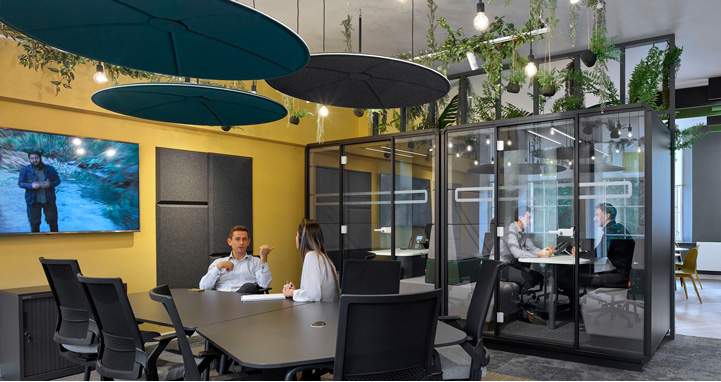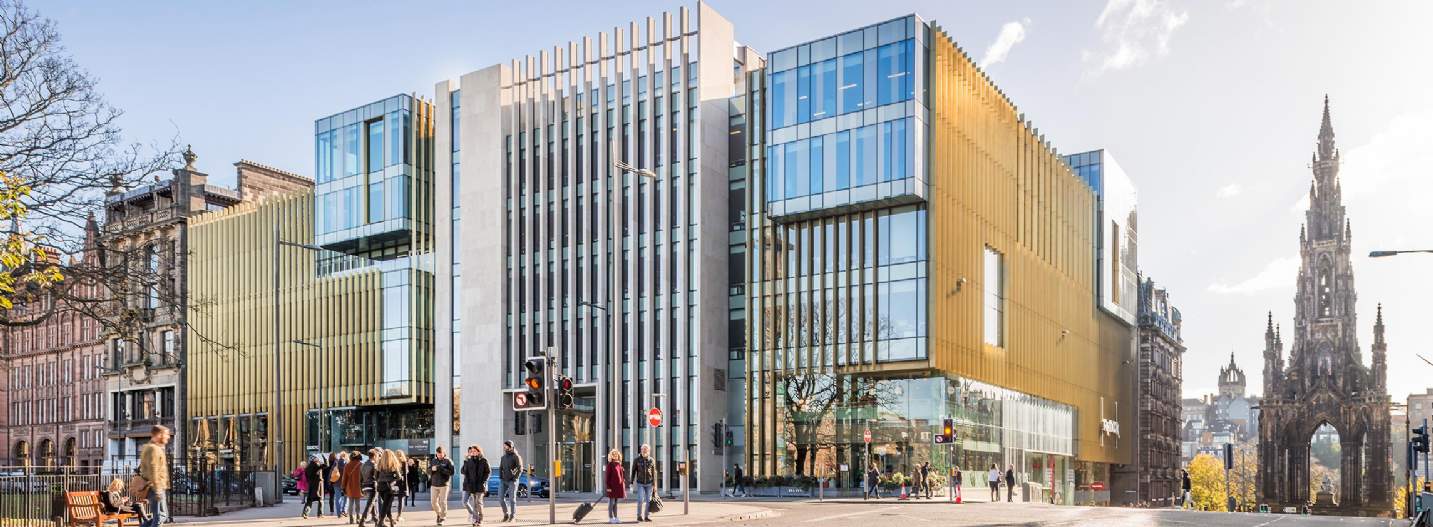'Insurance & Financial Services' is a key pillar of the Edinburgh office market
Edinburgh has a long-standing history in Insurance and Financial Services (IFS), establishing itself as the second largest financial centre in the UK, outside of London. IFS was worth an estimated £6.4bn to the Edinburgh economy in 2022, accounting for 25% of the city’s economic output. As a result of this strength, employment levels in the sector have been strong, with over 35,000 people in employment in 2022, which accounts for over 20% of the city’s office-based workforce.
Edinburgh has recorded more Insurance & Financial Services take-up than any other Big 6 city over the last five years
Clare Bailey, Director, Commercial Research
This raises the question of whether office demand has reflected this in the city centre. A quick look at the data shows that IFS occupiers have been the most active sector in the market over the last five years. Between 2018 and 2022 there was 800,000 sq ft of IFS take-up, which accounted for 30% of the overall total. This made IFS comfortably the strongest performer in the market, with ‘TMT’ the second most active sector, accounting for 19%, and ‘Professional’ in third, accounting for 14% of total take-up.
The same story was also seen when placing this demand in the wider UK Big 6 context. Between 2018 and 2022, no city recorded more IFS activity than Edinburgh, which accounted for 33% of Big 6 IFS total of 2.4m sq ft. When you consider that from a total take-up perspective, Edinburgh accounts for just 12% of the Big 6 total over the same period, you begin to uncover the strength of IFS demand in the Edinburgh market. This demand has also remained resilient despite the challenges of the pandemic, with 70% of 2018–2022 take-up coming after the end of Q1 2020.
Will this demand continue moving forward?
Over the past three years, major IFS organisations have made a significant investment to strengthen their office presence in the Edinburgh market.
In 2020, Baillie Gifford signed a 280,000 sq ft lease at M&G’s Haymarket development. This created a 20-year commitment to one of the best office spaces in Edinburgh.
More recently, BlackRock has also expanded its operations in the city centre. At the end of 2022, it was announced that the financial services giant had taken 140,000 sq ft to relocate to 20 Brandon Street. When the move has completed in 2025, BlackRock will have increased its Edinburgh office presence by 62% from its previous space at Exchange Place. Evidence of such market leaders committing their longer-term futures to Edinburgh can only be positive for the market.
Looking at the sector from an employment and economic perspective, recent data is also positive. Despite the economic challenges faced by the UK economy, the latest data from LinkedIn shows that the number of employees in IFS in Edinburgh grew over the last 12 months by 3.5%. Equally, the latest Oxford Economics forecasts project that IFS-based GVA will grow by 13% in Edinburgh over the next ten years, which is likely to continue to drive IFS demand moving forward. Whilst a number of organisations from within the IFS, TMT and Professional sectors have downsized since the pandemic, many are still growing, at least partially offsetting the effects of hybrid working. Similarly, there is strong evidence of a flight to well-located, sustainable buildings providing quality accommodation within these sectors, which will continue to create significant movement and opportunity in the market.

Conserving, recycling and repurposing
By prioritising the refurbishment of buildings, wherever possible, landlords are significantly reducing the use of raw materials and the embodied carbon
At only 0.6 years, Edinburgh has one of the lowest Prime office supply levels in the Big 6 markets, based on average demand. So unsurprisingly, the choice for occupiers in the city centre remains critically low, with the city centre currently starved of well-located, high-quality offices that provide sustainable accommodation along with good wellness facilities for staff. Difficulty finding the perfect space was clearly illustrated by BlackRock’s office search, with 20 Brandon Street ultimately becoming the only single building in the city that would allow the company to house all its employees under one roof.
However, where there are challenges, there are also opportunities. Investors and developers now have an opportunity to create better spaces within the existing built environment while aligning themselves with the new National Planning Framework 4 (NPF4). This was adopted by Scottish Ministers on 13 February 2023 and has been produced to align with the declared climate emergency.
Development in Scotland is plan-led, and NPF4 will now form part of the statutory development plan, supported by Local Development Plans and associated guidance in each area. We are already seeing an impact on the Commercial sector, whereby the new aims to tackle the climate crisis are resulting in a focus towards the reuse of existing buildings and the presumption against demolition. In fact, it is estimated that around 80% of the buildings that will be standing in 2045 have already been built, so a major priority is decarbonising our existing stock in line with up-to-date legislative requirements.
It is estimated that 80% of the buildings that will be standing in 2045 have already been built
Clare Bailey, Director, Commercial Research
Edinburgh has several refurbishment projects in the city which are already in the pipeline, including New Clarendon (34,000 sq ft), Edinburgh One (88,000 sq ft), and 30 Semple Street (57,000 sq ft). Repurposing existing buildings can typically save 50–70% of the embodied carbon associated with new construction.
Verdant, in West Edinburgh, is a recently finished 70,000 sq ft refurbishment that has been effective in this area. The landlord, CEG, has prioritised the refurbishment of the building to significantly reduce the use of raw materials and, therefore, the embodied carbon produced by the project compared to a new development. Across the UK, they also seek to upgrade old equipment and include innovative technologies to help drive improvements to their energy efficiency and thus reduce the energy consumption and carbon footprint of their properties. CEG is continuing to improve the green credentials of its buildings through a number of national initiatives. It has moved to a 100% renewable electricity tariff in order to minimise the environmental impact and encourage the renewable sector. There is also a lean towards the ‘S‘ of ESG, with Verdant offering a café and comprehensive cycle amenity repair station.
As the evolution of the office gathers pace, so does the desire to make workspaces a destination that combines work and wellbeing with a more autonomous and flexible form of personal and professional development. Workplace that leans towards flexibility, collaboration and culture to attract ‘future’ talent is key. Savills Edinburgh office is a notable example of a comprehensive refurbishment and one which used workplace analysis data to shape a new occupancy strategy and design. The data challenged the perception that additional floor space was required in order to accommodate the existing staff and projected future growth. With support from the wider business, the local management team decided to remain on their existing floor plates and undertake a comprehensive in situ refurbishment in order to support a fully agile office model. As well as significant and tangible financial benefits, the refurbishment brought a number of floors together to promote a ‘buzz’ around the office — based on a group decision that a more dynamic office would drive collaboration and teamwork.
Companies who adopt this ’wellness generation’ view will be much more successful in attracting, retaining and engaging the most powerful generation in the workforce today.
In terms of what this means for Edinburgh, fostering this approach is clearly going to be vital moving forward. The development pipeline for new build space remains incredibly thin, with just 80,000 sq ft of new build space set to be delivered between now and 2025. Given that it is estimated that 80% of the buildings that will be standing in 2045 have already been built, the market must now look to these refurbishment projects as an opportunity to reduce embodied carbon emissions but also as a necessity to meet the growing demand for best-in-class product in the market.
Related articles are available here:
Latest Savills forecasts revealed
New Scottish Planning Policy prioritises the climate change emergency
Scotwind: Over £28 billion of investment represents one big opportunity for Scotland
Scottish residential market ‘resilient’ and set to outperform the wider UK market
